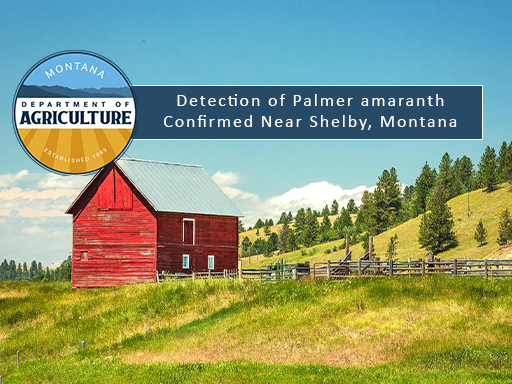Detection of Palmer Amaranth Confirmed Near Shelby, Montana

CONTACT:
Logan Kruse, Montana Department of Agriculture, (406) 444-3684
Jasmine Chaffee, Montana Department of Agriculture, (406) 444-3140
Detection of Palmer Amaranth Confirmed Near Shelby, Montana
HELENA, Mont. – The Montana Department of Agriculture (MDA) confirmed Palmer amaranth in a residential planter near Shelby, Montana. This is the first case of Palmer amaranth confirmed in Montana.
Palmer amaranth (Amaranthus palmeri), a fast-growing, prolific-seeding pigweed, has been confirmed in Montana for the first time. A single male plant was found growing in a residential planter near Shelby, MT, most likely introduced from contaminated birdseed; no seed was produced. The site will be monitored for the next several years to ensure no additional plants emerge.
Palmer amaranth has smooth stems, long leafstalks (petioles), long, thin seedheads, and it tends to grow much taller than other common “weedy” pigweeds. Palmer amaranth is dioecious, meaning it has both male and female plants, which allows it to quickly become genetically diverse and easily develop herbicide resistance. Common vectors of spread include millet, sunflower screenings, and farm equipment.
The Montana Department of Agriculture recommends using caution when moving around equipment or purchasing seed and feed, especially when it is from Palmer amaranth infested states. There is a zero tolerance for Palmer amaranth seed in Montana stated in ARM 4.12.3011 and the Palmer Amaranth Task Force is willing to help landowners identify and manage all populations.
To report a suspected Palmer amaranth plant, contact your local county weed district, MSU Extension agent, or the Montana Department of Agriculture. Leave the plant in the ground so it can be correctly identified, take plenty of pictures, record GPS coordinates, and arrange for a site visit as soon as possible. Identification is difficult, so most suspected plants are genetically tested. For additional resources and contact information, visit the Early Detection, Rapid Response webpage here: agr.mt.gov/Noxious-Weeds.
The Montana Department of Agriculture is serving Montana Agriculture and growing prosperity under the Big Sky. For more information on department programs and services, visit agr.mt.gov.
###
Tags: Noxious Weeds and Palmer Amaranth
